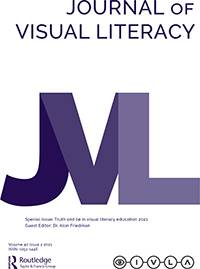Visual Literacy
There is a good chance that GVSU faculty use visual content in our course instruction. Examples include sculpture, charts, maps, paintings, video, drawings, physical objects, photographs, natural settings and even live performances. How effective we are in using such content? The cross-departmental Visual Literacy Team (VLT) conducted a faculty survey back in December, 2019 and here are the results.
How GVSU Faculty Integrate Visual Content in Their Teaching (an infographic)
The team is using this information to develop faculty professional development in the concept of visual literacy and in the recommended practice for using visual content. The training will be pilot tested in the fall. On behalf of the VLT; we thank all of you who took the time to complete the survey and inform our work. Contact team leader Salvatore Alaimo at [email protected] with any questions concerning this information or the work of the team.
Association of College and Research Libraries (ACRL) visual literacy definition and standards.
The International Visual Literacy Association (IVLA) is an interdisciplinary organization of professionals working toward a fuller understanding of the way we derive meaning from what we see and the way we interact with our visual environment.

The International Journal of Visual Literacy publication is available through the GVSU libraries.
Review the Educational Video Checklist provided by GVSU eLearning.
Visual Literacies: Concepts and Methods

Visual Literacies: Concepts and Methods
NEW SERIES ALERT!
On a daily basis, our students negotiate a myriad of visual media, within and beyond the classroom. How can we support their engagement with these materials in nuanced and informed ways? This series offers participants an introduction to core concepts and practices associated with visual literacy. The sessions can be taken independently, but also are designed to complement one another. Consider combining two or more workshops bridging theory with practice to support student learning.
22W Visual Literacies: Concepts and Methods
This workshop will me in-person on the Pew Grand Rapids campus.
Concepts of visual literacy are explored through the various aspects, components and contexts that determine what we see, how we see, and how we, as individuals, socially construct meaning from what we see. This introductory session is part of a series of learning modules that will help faculty and staff to improve how we utilize visual content in our teaching, training, and learning. The series was developed by a cross-departmental team within our university, and incorporates the results of a GVSU faculty survey in 2019.
Facilitated by Sal Alaimo, School of Public, Nonprofit, Health, Hospitality and Tourism Management.
This workshop will meet in-person on the Allendale campus.
This session expands upon basic concepts of visual literacy. We will explore how visual information is interpreted by viewers based on their prior knowledge and cognitive ability. We’ll also look at the ways in which social and cultural identity impact understanding. This session will also include a guided group “reading” of an artwork in the library to practice looking, reflecting, and discussion in the service of building observational skills.
Facilitated by Amanda Rainey, Art Gallery, Matthew Roberts, eLearning Technologies, and Stacey Burns, University Libraries.
This workshop will meet virtually via Zoom.
In this session we will talk about the possibilities of using video as a means to assess student learning. Before we meet we'd encourage you to think of ways in which this may be possible in the courses that you teach as we will try and help you determine what visual literacy skills and technical skills will be necessary to successfully teach and engage your students.
To get the most out of this workshop, it would be ideal if you could come prepared with at least a few slides that you have developed and plan on turning into a video presentation.
Facilitated by Noah Campbell, eLearning Technologies, Justin Melick, eLearning Technologies and Kyle Macciomei, eLearning Technologies.
This workshop will meet in-person on the Allendale campus.
Visual literacy asks us to engage deeply with observation, but also asks us be responsible to context as we select images to support student learning. This session combines discussion and workshop activities to address the spectrum of ways context is an important factor when creating course materials. Together, we will consider the informed selection of images as well as engage with the ethical contexts for their creation, reception, and reuse.
To make the most of this workshop, participants should come with a laptop and a PDF of a classroom lesson that incorporates images. We will use these as a starting point for our work together.
Facilitated by Sigrid Danielson, Visual and Media Arts, and Melissa Morison, Classics Department.
Helpful Videos
- Visual Literacy. (2018). Makematic. 4:35 – available from GVSU University Libraries (Infobase Films on Demand)
- Introduction to Art: Visual Literacy. (2016). Discovery Education. 27:43 – available from GVSU University Libraries (Infobase Films on Demand)
- What is visual literacy with Steve Moline. (2008). Stenhouse Publishers. 45:00 – available from GVSU University Libraries (Alexander Street)
- Introduction to photography and visual literacy. (2005). San Mateo County Community College District. Films Media Group. – available from GVSU University Libraries (Infobase Films on Demand)
- What is Visual Literacy? (with Brian Kennedy). (2013). Toledo Museum of Art. 15:30. – available through YouTube
- TEDxDartmouth - Brian Kennedy - Visual Literacy: Why We Need It. (2010). 16:03. – available through YouTube
- Martin Scorsese on the Importance of Visual Literacy. (2012). Edutopia. 10:43 – available through YouTube
Bibliography of Resources
Baines, L. A. (2008). Teacher’s guide to multisensory learning. Washington, D.C.: Association for Supervision and Curriculum Development.
Benjamin, Walter. (1968). The Work of Art in the Age of Mechanical Reproduction. Illuminations. New York: Schocken Books.
Berger, John. (1973). Ways of Seeing. New York: Penguin Books.
Burmark, Lynell. (2002). Visual literacy : learn to see, see to learn. Alexandria, Va.: Association for Supervision and Curriculum Development.
Campos Alfredo, Jose Luis Marcos, and Maria Angeles Gonzalez. (1999). Emotionality of Words as Related to Vividness of Imagery and Concreteness. Perceptual and Motor Skills 88: 1135–1140.
Eilam, B., & Ben-Peretz, M. (2012). Teaching, learning, and visual literacy: The dual role of visual representation. New York: Cambridge University Press.
Elkins, J. (Ed.). (2009). Visual literacy. New York: Routledge.
Messaris, Paul. 1994. Visual Literacy: Image, Mind and Reality. Boulder: Westview Press, Inc.
Mitchell, W.J.T. 1986. Iconology: Image, Text, Ideology. Chicago: University of Chicago Press.
Mitchell, W.J.T. 1995. Picture Theory. Chicago: University of Chicago Press.
Mitchell, W.J.T. 2005. What do Pictures Want: The Lives and Loves of Images. Chicago: University of Chicago Press.
Nisbett, Richard E. and Lee Ross. 1980. Human Inference: Strategies and Shortcomings of Social Judgment. Englewood Cliffs: Prentice Hall.
Pink, S. 2021. Doing Visual Ethnography: Monash University, Australia

